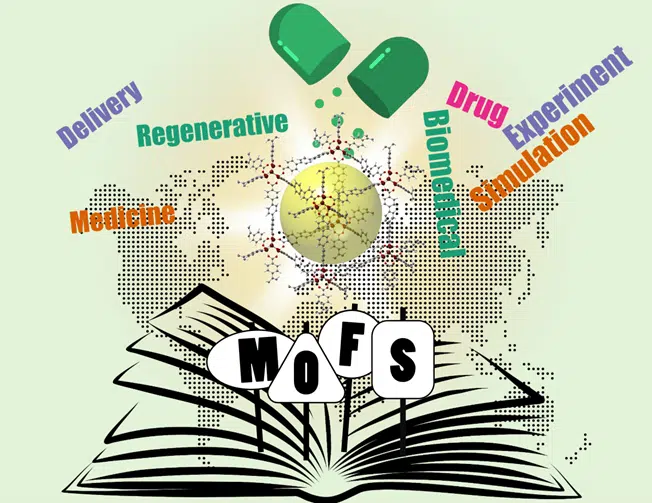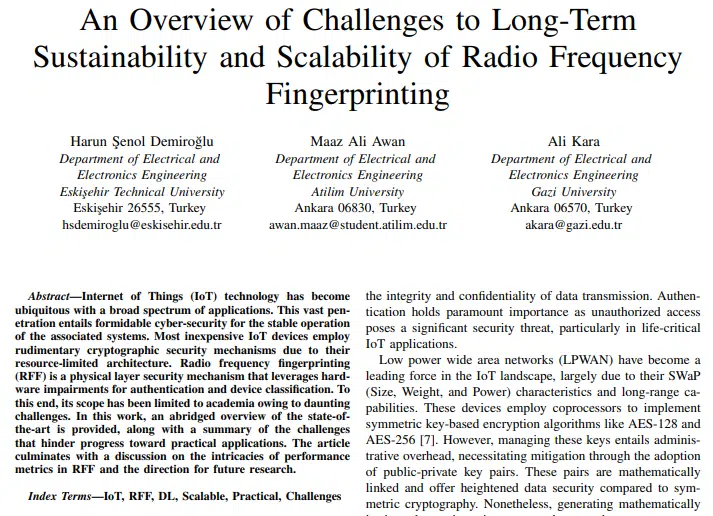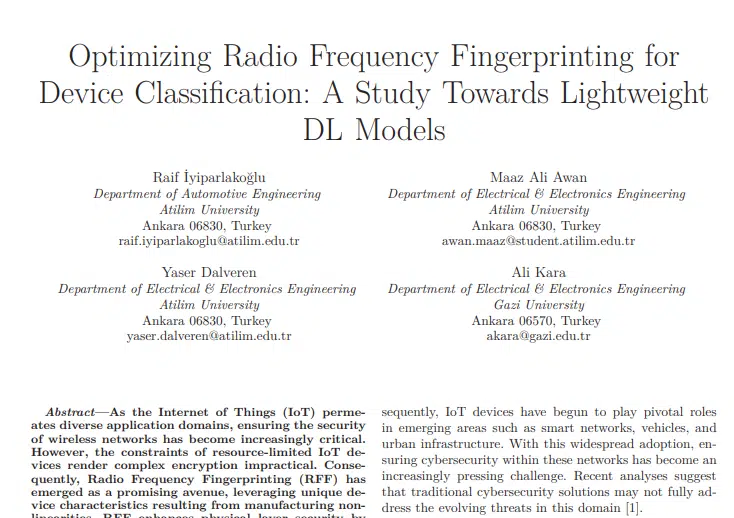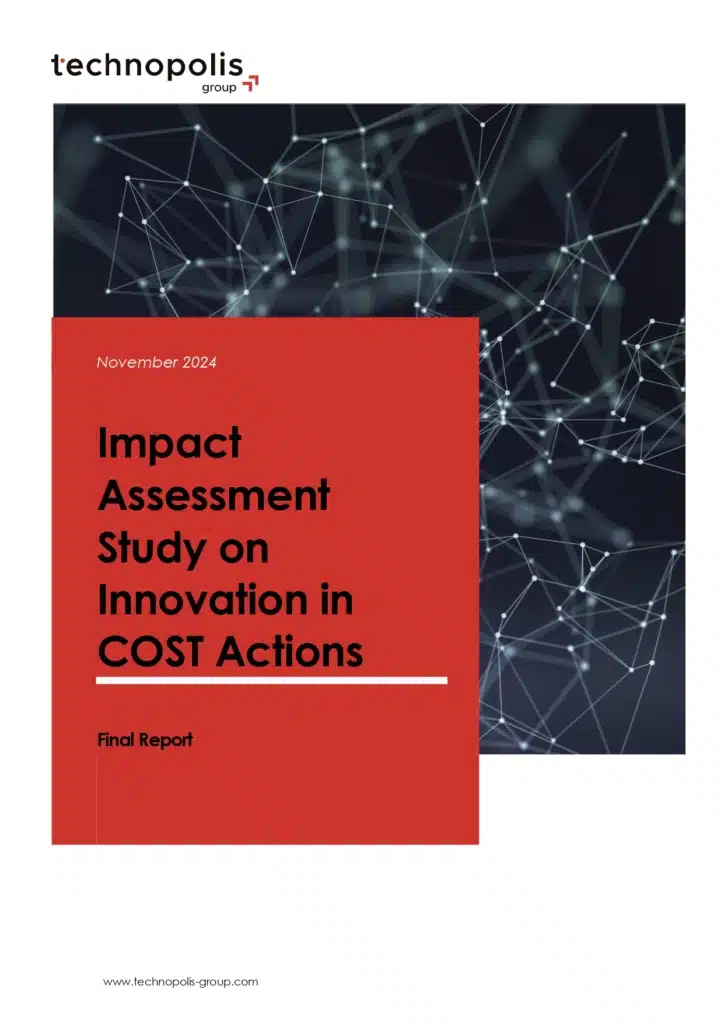
Biomedical Applications of Metal-Organic Frameworks Revisited
DOI: https://doi.org/10.1021/acs.iecr.4c03698
In the past decade, metal-organic frameworks (MOFs) have been extensively researched for biomedical applications, particularly drug storage, after proving to be excellent substitutes for traditional porous materials. Biomedical applications of MOFs have been greatly expedited with the recent integration of data science and molecular modelling approaches to experimental research, establishing them as essential elements in medical imaging, diagnostics, and regenerative medicine. In this review, to demonstrate the potential of MOFs in cutting-edge treatments for neurological and cancer diseases, we examined the molecular interactions between MOFs and biological systems and discussed the field’s opportunities and challenges.

An Overview of Challenges to Long-Term Sustainability and Scalability of Radio Frequency Fingerprinting
https://doi.org/10.1109/ICCSPA61559.2024.10794273
The Internet of Things (IoT) is transforming industries with its plethora of applications, from smart cities to healthcare. However, this rapid proliferation comes with a pressing need for additional cybersecurity needs to ensure stable and resilient operations. Resource-constrained IoT devices often rely on basic cryptographic mechanisms, allowing innovative solutions like Radio Frequency Fingerprinting (RFF) to thrive and enhance physical layer security. As part of European Union COST Action, this study dives into the current state-of-the-art in RFF, a technique that utilizes unique hardware characteristics for device authentication and classification. Key Takeaways: Challenges in Real-World Deployment: While RFF has shown promise in academic settings, its practical applications are limited by technological barriers. There is a burgeoning need to deliberate the potential CONOPS (concept of operation) and operational scenarios encountered in real world deployment. The research sheds light on critical performance metrics and the complexities of evaluating RFF systems. By addressing these challenges, the study lays a foundation for advancing RFF from theory and controlled environment to practical implementation, enabling its integration into secure IoT ecosystems. By connecting this work to the COST action, we aim to foster collaboration across Europe to develop cutting-edge security solutions for networks of the future.

Optimizing Radio Frequency Fingerprinting for Device Classification: A Study Towards Lightweight DL Models
https://doi.org/10.1109/ICCSPA61559.2024.10794386
We developed a lightweight 1D Convolutional Neural Network (CNN) model optimized for edge devices, reducing inference latency while maintaining high classification accuracy. Using an open-source dataset of 30 LoRa devices, we evaluated preprocessing methods (Short Time Fourier Transform (STFT) and Fast Fourier Transform (FFT)). Our approach demonstrated: A significant reduction in inference latency, making deployment on real-time edge devices feasible. Comparable classification accuracy when benchmarked against a 2D CNN model. This work not only bridges a crucial gap in the literature but also propels the adoption of RFF for edge devices—an essential step for secure IoT networks in 6G. By aligning this effort with COST Action, we aim to foster collaboration across Europe to achieve secure, resilient, and trustworthy 6G systems.

“Sweet MOFs”: exploring the potential and restraints of integrating carbohydrates with metal–organic frameworks for biomedical applications
DOI ref: https://doi.org/10.1039/D4NH00525B
This review highlights recent advancements in combining metal–organic frameworks (MOFs) with carbohydrate chemistry to create biocompatible systems for biomedical applications. MOFs offer unique properties like biodegradability, low toxicity, and high surface area, enabling functionalization with biological ligands and the loading of active cargos, from small drugs to biomacromolecules. Recent research focuses on leveraging carbohydrate chemistry to functionalize and modify MOF structures, aiming for efficient and naturally inspired designs. The review discusses the field’s progress over the past five years, addressing both its potential and challenges, including sustainability and real-world applicability.

A sustainable lecithin-based ligand for the bio-functionalization of iron and hybrid metal organic frameworks (MOFs) nanoparticles with the sugar mannose
DOI ref: https://doi.org/10.1039/D4GC03743J
A sustainable and eco-friendly ligand for diverse nanoparticles functionalization is reported. The ligand is synthesized through a photochemical reaction between lecithin and cysteine, followed by the addition of mannose, a sugar beneficial for biomedical targeting. The environmental impact of the ligand is assessed through green metrics, demonstrating superior sustainability compared to conventional ligands. The ligand is successfully applied to various nanoparticle platforms, including the MOFs MIL-101(Fe), PCN-222, UiO-66, and iron nanoparticles, highlighting its potential for safer and more effective applications in nanomedicine.

Gender Equality Plan template for COST Actions
The COST Administration encourages the development of a COST Action Gender Equality Plan (GEP). In order to assist Actions that wish to develop a GEP, COST has developed a template that can be customised with a networks needs, preferences, and priorities.

Impact Assessment Study on Innovation in COST Actions
COST Association commissioned Technopolis to carry out an impact assessment to better understand impact pathways that lead to innovation. While the impact paths foreseen by the COST impact model were analysed in previous studies, this study fills the knowledge gap regarding the different types of and paths to innovation of COST Actions.
The case studies illustrate various ways in which COST Actions can be innovative in their design and implementation and highlights how COST Actions can also result in various innovative outputs, like business models, new products (patents) or educational formats.

Securing the Internet of Things: Challenges and Complementary Overview of Machine Learning-Based Intrusion Detection
The significant increase in the number of IoT devices has also brought with it various security concerns. The ability of these devices to collect a lot of data, including personal information, is one of the important reasons for these concerns. The integration of machine learning into systems that can detect security vulnerabilities has been presented as an effective solution in the face of these concerns. In this review, it is aimed to examine the machine learning algorithms used in the current studies in the literature for IoT network security. Based on the authors’ previous research in physical layer security, this research also aims to investigate the intersecting lines between upper layers of security and physical layer security. To achieve this, the current state of the area is presented. Then, relevant studies are examined to identify the key challenges and research directions as an initial overview within the authors’ ongoing project.

Reinforced funding for research networks: statement from COST’s Scientific Committee
In this statement COST’s Scientific Committee urges the European Commission, European Parliament, and Member States to increase the budget allocated to COST in order to fund at least 50% more new Actions per year and reinforce COST’s role as a capacity builder.
